4 Active Adventures in Olympic National Park
This article originally appeared on My Olympic Park
From glassy lakes and rainforest hikes to high peaks and beautiful, cold beaches, Olympic National Park has an ecosystem for everyone. If you want to test your body and go on an incredible adventure beyond the park's roads, you've come to the right place. We've put together four active adventures to tackle in this beautiful area of northwestern Washington.
Paddle and Camp on Lake Ozette
The crystal-clear waters of Olympic National Park's largest lake make Lake Ozette an incredible place to go for an overnight paddle. Situated in a temperate rainforest, this freshwater lake is just off the Pacific Coast, sitting at just 32 feet above sea level.
There aren't boat rentals at Lake Ozette, so rent a canoe or a kayak in Port Angeles and ferry your boat to Lake Ozette on your car.
Lake Ozette can be as flat as a pane of glass or extremely dangerous and choppy with two-foot waves. Start your paddle early in the morning to give yourself the best chance of calm waters and always wear your life jacket. Park at the Ozette Ranger Station and launch your canoe or kayak from the boat launch. Follow the western shoreline for a beautiful 4-mile paddle to Erickson's Bay. This boat-only camping area is tucked under towering trees on the shores of the lake. Beach your boats and set up camp.
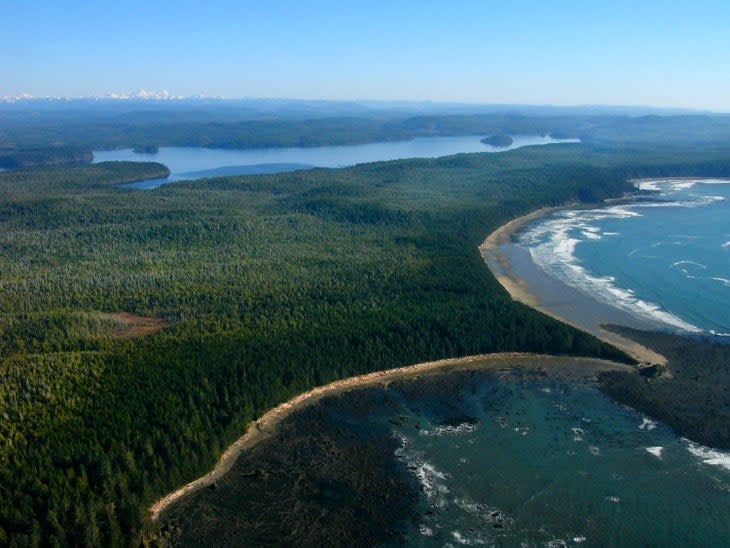
Bear proof food canisters are required when backcountry camping anywhere in the park. You can borrow one from the park's Wilderness Information Center in Port Angeles. There are black bears in the park, but raccoons and other small critters also tend to get into food and scented items. Store anything edible or scented in the canister.
If the paddle to your campground wasn't enough of an adventure for you and the lake is calm, take your boat back out on the water and head just south of your campsite along the shoreline. Beach your boat and take the Erickson Bay Primitive Trail 2 miles through the forest and you'll end up at the Pacific Ocean. Be sure to give yourself plenty of time for the return hike and paddle to your campsite before dark.

Lake Ozette is extremely cold. There have been fatalities from people going overboard and drowning in the shockingly cold water. It's a good idea to wear a wet suit on your paddle to your campsite. Avoid going overboard at all costs.
All backcountry campers are required to have a permit in Olympic National Park. Permits become available six months in advance of your desired trip date on recreation.gov.
Ski or Snowshoe Hurricane Ridge
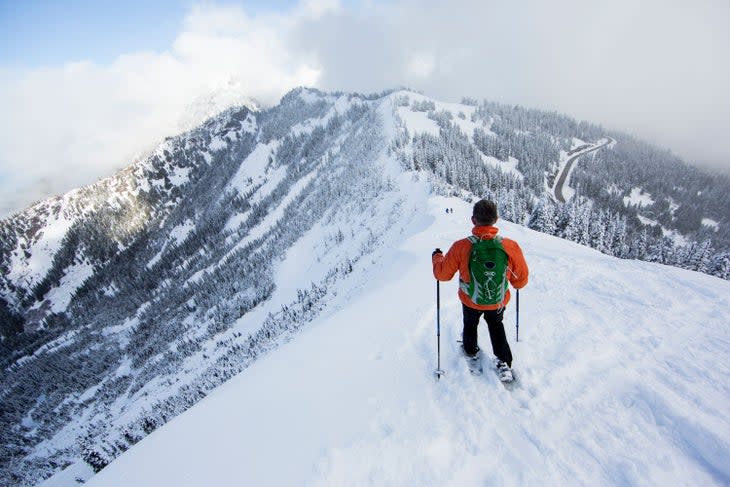
Hurricane Ridge sits at almost a mile high, bringing snow to its meadows in the winters. A local winter sports club operates the Hurricane Ridge Ski & Snowboard Area, one of the only downhill ski areas in a national park, but if you prefer to tackle the uphills on your own without the help of a rope tow or Poma, you can also explore Hurricane Ridge by cross-country ski or snowshoe.
Hurricane Ridge Road, which starts in Port Angeles and climbs to the Hurricane Ridge Visitor Center, is usually open Fridays, Saturdays and Sundays through the winter from 9 a.m. to 4 p.m. This depends on weather and can change, so it's always a good idea to call the hotline at (360) 565-3131 for the latest conditions. Parking can fill up quickly, so plan on heading up to Hurricane Ridge as soon as the road opens to avoid having to wait for a parking spot.
At the top, you can rent snowshoes at the Hurricane Ridge Rental Shop, which opens at 10 a.m. Some seasons they have cross-country ski rentals as well.
From the visitor center, ski or snowshoe west on Hurricane Hill Road, which isn't plowed or groomed from the visitor center in the winter. Enjoy 1.5 miles of stunning views and easy grades before turning around where the road ends. If you're an experienced backcountry skier or snowshoer, you can continue on to tackle the steep Hurricane Hill that's summit tops out at 5,757 feet. This route is rated difficult and passes under avalanche terrain. If you choose to venture out this way, check in on the avalanche forecast in the visitor center ahead of time and be sure you're carrying avalanche rescue gear like a beacon and probe and know how to use them. Never venture into avalanche terrain alone.

Wolf Creek Trail and Obstruction Point Road are more moderate routes that also leave from the area around the visitor center and aren't usually in avalanche terrain.
Be sure to be prepared for cold and snowy weather as the weather in Port Angeles is not a good gauge as to what conditions will be like up top. Pack plenty of synthetic or wool layers (no cotton) to keep you warm and dry no matter the conditions. Bring lots of sunscreen and water as the sun is intense when it pokes out of the clouds and the elevation can quickly dehydrate you when you're working out.
Backpack through Seven Lakes Basin
This active adventure is in one of the most magical spots in Olympic National Park, Seven Lakes Basin. Home to picturesque alpine lakes, wildflower covered meadows, abundant wildlife and unobstructed views of the Olympic Range, the 18-mile backpack through the basin is justifiably one of the park's most popular.
While other areas of Olympic are a bit more casual when it comes to where exactly you pitch camp, the Seven Lakes Basin is so popular you will have to reserve individual sites for individual nights when applying for your wilderness permit. This means you'll need to decide in advance whether you want to tackle the loop clockwise, or counterclockwise. This might be dictated by the availability of permits as this area is extremely popular.
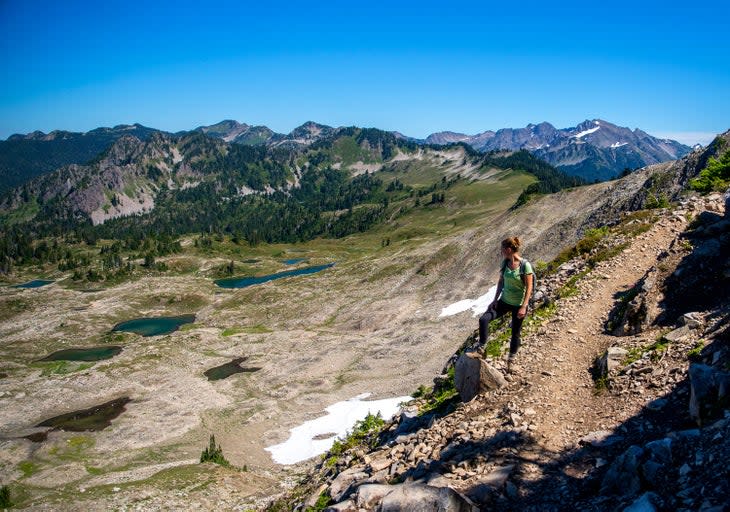
This 18-mile loop is often done in three days, but if you can get the permits, you can extend it to a longer trip to fully explore the basin. Heart Lake and Lunch Lake are the most popular campsites as they are nestled along some of the most picturesque lakes on the loop. Both areas have multiple sites apiece. Going clockwise, you'll want to camp at Heart Lake, 7.4 miles from the trailhead. The hike to Heart Lake is quite steep, gaining 3,900 feet of elevation. If this is too intense for one day, or if you can't get a permit for Heart Lake, Upper Sol Duc is a good choice at 5.7 miles and approximately 2,700 feet of elevation gain.
From Heart Lake, it's 4 miles and 1,600 feet of elevation gain and almost 2,000 feet of descent to Lunch Lake. From Lunch Lake, it's 7.6 miles back to the trailhead with more than 4,000 feet of elevation loss. For a milder last day, extend your trip to three nights and stay at Deer Lake, making the final day 3.4 miles with a little more than 2,100 feet of descent. There are plenty of other route options if Heart Lake or Lunch Lake are full, but these two camping areas are the most popular for good reason. Not only are they gorgeous, but they are also ideally located to spread the hiking and exploring out over three days. See above information under the Paddle and Camp on Lake Ozette section for obtaining wilderness permits and on storing food.
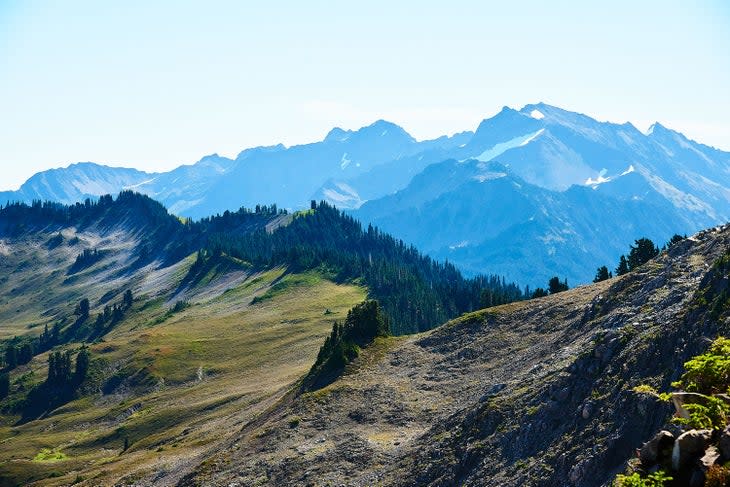
The trail starts from the Sol Duc Falls Trailhead (note, some park signage spells it "Solduck.") Follow the trail for just under a mile through the rainforest until you come to the trail's namesake waterfall. To go clockwise, continue on the Sol Duc River Trail. As you continue through the beautiful temperate rainforest, you'll pass the junction for Appleton Pass. Following it will add several miles to your hike. Instead, stay right on the Sol Duc River Trail until you reach Heart Lake. This lake is shaped like a perfect, blue heart and makes for a fabulous place to spend the evening surrounded by the towering peaks of the Olympic Range. There are privies at the group sites at Heart Lake and Lunch Lake, but only use them for solids and toilet paper to keep them from filling up too quickly. If you just have to pee, do it on a rock or other hard surface to keep mountain goats from destroying vegetation to get after the salt in your urine.
On your way to Lunch Lake on day two, you'll quickly come to the junction with the High Divide Trail. This stunning trail is out of the trees with incredible views of the Seven Lakes Basin on one side and towering Mt. Olympus and its sister peaks of the Olympic Range on the other. There isn't water between the two lakes, so be sure to filter plenty before hitting the trail. Stay on the High Divide Trail when it comes to an intersection with the Mirror Lake Way Trail. Since this is a shorter day, you can spend your time soaking in the views. If you have the energy, climb to the top of Bogachiel Peak, which only adds another 100 feet of elevation gain but provides incredible views of the basin. From the High Divide Trail, take the Lunch Lake Trail to your campsite. Off this route there are several other trails to various lakes such as Round Lake, Mirror Lake and Clear Lake which makes for a great afternoon of exploring.
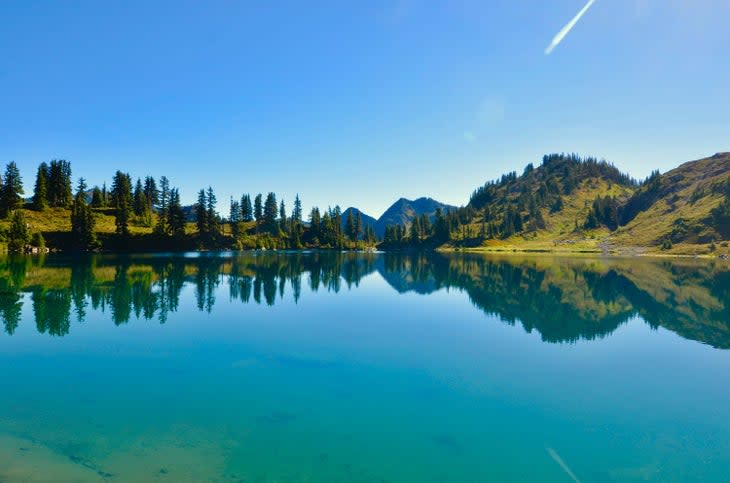
On day three, head back to the High Divide Trail and follow it as it meanders through the basin, past some smaller lakes, until it finally ends at Deer Lake. From here, hop on the Deer Lake Trail and follow it back through the forest, descending to Sol Duc Falls and back to the trailhead.
After three days spent on the trail, nothing feels better than a soak at Sol Duc Hot Springs.
Much of this trail goes through a temperate rainforest, so it's important to be prepared for lots of precipitation. Pack rain clothes, like a rain jacket and rain pants in case it starts raining as you hike. A waterproof pack cover is also a great idea to keep your gear from getting soaked. Waterproof boots and quick dry clothing (no cotton) is going to be essential for this hike. Definitely pack the rain fly as well.
Hike to Royal Lake
While the 15.6-mile trek to Royal Lake would certainly make a good backpacking trip, determined and fit hikers can take on the challenge as a day hike. It's a long and steep hike, but the payoff of the Gatorade-blue waters of Royal Lake reflecting back the snow-capped peaks that tower above them is well worth the effort. Plus, there's a truly stunning waterfall and a wildflower-strewn basin just past the lake.
This hike starts outside of the park at the Upper Dungeness Trailhead. This trailhead requires a $5 day-use parking fee, or for you to display your America the Beautiful annual pass on your dashboard.
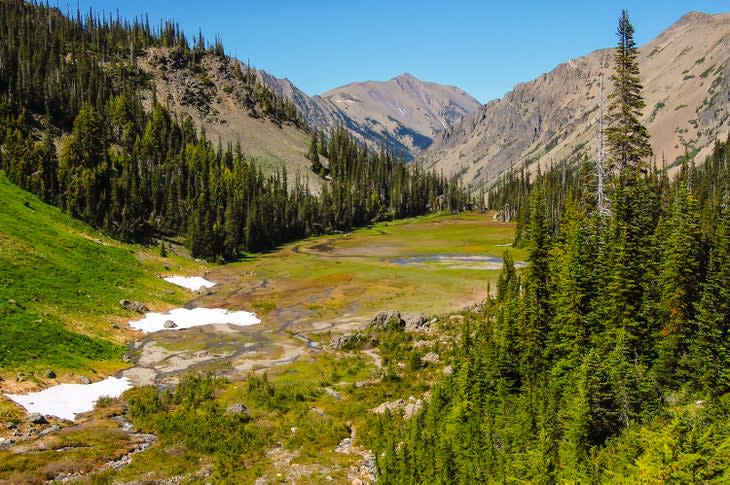
Follow the Upper Dungeness Trail for a mile where the grade is mild. Just before a bridge crossing Royal Creek, you'll come to a junction. Head right to join the Royal Basin Trail. Continue on as you begin to climb and when you reach the junction with the Mount Maynard Trail, stay left. You'll quickly enter Olympic National Park.
The hike winds through wildflowers and towering old growth firs and hemlocks, making it feel as if you've stepped into a children's book.
You'll leave the trees and enter rocky, open stretches with gorgeous views. Switchbacks will become common place as you continue to climb. After 7.8 miles and a little more than 3,900 feet of elevation gain, you'll find yourself at the picturesque shores of Royal Lake. Take in the stunning views and enjoy a picnic. This might be plenty of exertion for some, but if you have the energy, it's well-worth it to continue on another quarter of a mile to the base of Royal Basin Falls. This 60-foot waterfall is nearly as wide as it is tall and is picture perfect.

Another mile up the trail will bring you to Upper Royal Basin, which is filled with stunning blue tiny lakes, called tarns, wildflowers and plenty of marmots scurrying about. This area is probably best saved for those backpacking.
If you choose to do this as a backpacking trip, you will need to obtain a wilderness permit. See the information above under the Lake Ozette section on obtaining a permit.
For exclusive access to all of our fitness, gear, adventure, and travel stories, plus discounts on trips, events, and gear, sign up for Outside+ today.
